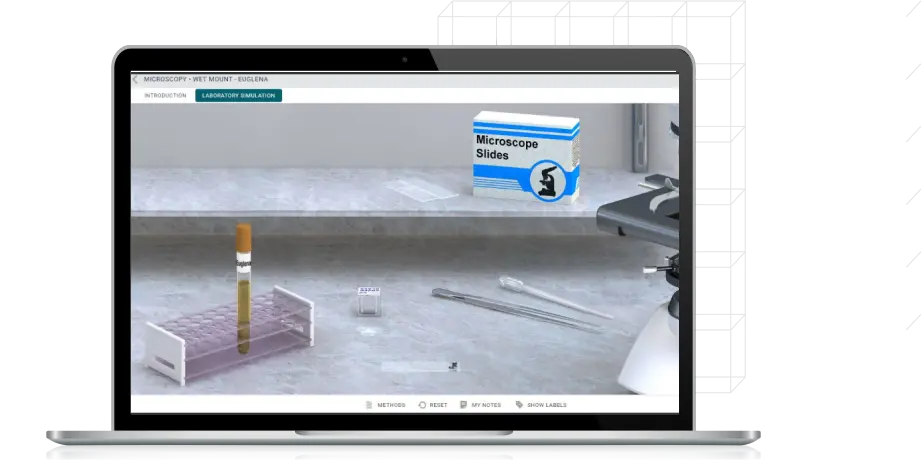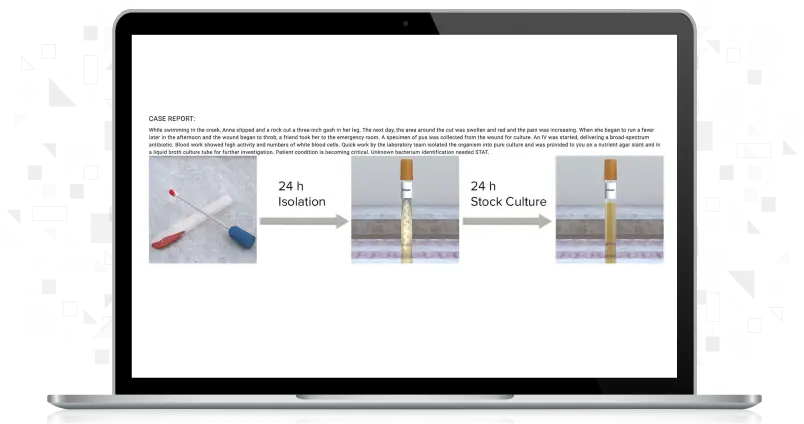
Staining: Gram Staining
In this simulation, you will practice the preparation of the major bacterial visualization protocol known as Gram staining.
McGraw Hill will be performing site maintenance on Saturday, Dec. 20, 2025 from 6:00 - 10:00 a.m. ET. During this time, purchasing will be unavailable on www.mheducation.com.
We apologize for any inconvenience this may cause. Follow our system maintenance page for updates.
My Account Details
Log In to My PreK-12 Platform
Log In to My Higher Ed Platform
My Account Details
Log In to My PreK-12 Platform
Log In to My Higher Ed Platform
Grasp the scientific study of microorganisms with lab simulations covering a variety of topics—from cellular structure and gram staining to bacterial genetics.
Fields marked by * are required.
Your information will be used to provide you with the requested information and other information about McGraw Hill’s products and services. You may opt out at any time by contacting McGraw Hill’s local privacy officer or selecting “unsubscribe” at the bottom of any email you receive from us.


In this simulation, you will practice the preparation of the major bacterial visualization protocol known as Gram staining.

In these simulations, you will be provided with many different testing protocols that will help identify unknown bacteria.

In this activity you will conduct four antimicrobial sensitivity tests on isolated species of Staphylococcus or Streptococcus using blood agar plates and antimicrobial disks. This will help you learn to observe zones of inhibition and how to interpret those results.
1st Lab Tutorial:
Aseptic Technique:
• Broth Culture to Sterile Agar Plate
• Broth Culture to Sterile Broth
• Slant Culture to Sterile Agar Slant
Bacterial Genetics:
• Polymerase Chain Reaction (PCR)
Biochemical Testing (Unknown ID Tests)
• Antimicrobial Testing for Gram-Positive Cocci Identification
• Blood agar hemolysis test
• CAMP test
• Catalase test
• Citrate test
• Coagulase test
• Phenol red test (glucose fermentation)
• Triple sugar iron (TSI) agar
• Indole test
• MacConkey agar (lactose fermentation)
• Mannitol salt agar
• Methyl red test
• Voges-Proskauer test
• SIM medium
• Nitrate reduction test
• Oxidase test
• Urease Test
Cell Structure:
• Prokaryotic and Eukaryotic Cell Size, Shape, and Function
Control of Microbial Growth:
• Effect of Antiseptics and Disinfectants
• Antimicrobial Sensitivity Testing (Kirby-Bauer Method)
DNA Biology and Technology:
• Enzyme-Linked Immunosorbent Assay (ELISA) Testing (New)
• Transcription, Translation, and Mutation
• Climate change
• Water Quality
Evidence of Evolution:
Isolation Methods:
• Quadrant Streak Plate Method
• Quantitative Dilution of Bacteria
• Quantification by Colony Counting
Lab Safety:
Microbial Growth:
• Oxygen Requirements & Anaerobic Jar
• Oxygen Requirements and Fluid Thioglycolate Medium Tubes
Microscopy:
• Operation of a Brightfield Microscope
Natural Selection:
• Antibiotic-Resistant Bacteria
• Natural Selection in Insects
• Collecting a Sputum Specimen
Staining:
Ubiquity of Microorganisms
Unknown Bacterial Identification
1st Lab Tutorial:
Applying the Scientific Method:
Aseptic Technique:
• Broth Culture to Sterile Agar Plate
• Broth Culture to Sterile Broth
• Slant Culture to Sterile Agar Slant
Bacterial Genetics:
• Polymerase Chain Reaction (PCR)
Basic Chemistry:
• Synthesis of Calcium Carbonate
Blood:
• Differential White Blood Cell Count
Biochemical Testing (Unknown ID Tests)
• Antimicrobial Testing for Gram-Positive Cocci Identification
• Blood agar hemolysis test
• CAMP test
• Catalase test
• Citrate test
• Coagulase test
• Phenol red test (glucose fermentation)
• Triple sugar iron (TSI) agar
• Indole test
• MacConkey agar (lactose fermentation)
• Mannitol salt agar
• Methyl red test
• Voges-Proskauer test
• SIM medium
• Nitrate reduction test
• Oxidase test
• Urease Test
Cardiovascular Physiology:
Cell Division:
Cell Structure:
• Examining Plant & Animal Cells
• Prokaryotic and Eukaryotic Cell Size, Shape, and Function
Cellular Respiration:
• Measuring Energy Production in Plants
Chemical Composition of Cells:
Control of Microbial Growth:
• Effect of Antiseptics and Disinfectants
• Antimicrobial Sensitivity Testing (Kirby-Bauer Method)
Diffusion:
• Effect of Concentration on the Rate of Diffusion in a Semisolid
• Effect of Density of Media on the Rate of Diffusion
• Effect of Molecular Weight on the Rate of Diffusion in Air
• Diffusion Across a Selectively Permeable Membrane
Digestive System:
Dissections:
DNA Biology and Technology:
• Enzyme-Linked Immunosorbent Assay (ELISA) Testing (New)
• Transcription, Translation, and Mutation
Electromyography:
Endocrine System:
• Influence of Thyroid Hormone on Temperature Regulation
• Effects of Blood Glucose Level
Environmental Studies:
• Climate change
• Water Quality
Evidence of Evolution:
• Fossils and Comparative Anatomy
Eye and Vision:
How Enzymes Work:
Human Genetics:
• Chromosomal Inheritance During Meiosis
Isolation Methods:
• Quadrant Streak Plate Method
• Quantitative Dilution of Bacteria
• Quantification by Colony Counting
Lab Safety:
Mendelian Genetics:
Metric Measurement:
Microbial Growth:
• Oxygen Requirements & Anaerobic Jar
• Oxygen Requirements and Fluid Thioglycolate Medium Tubes
Microscopy:
• Operation of a Brightfield Microscope
Natural Selection:
• Antibiotic-Resistant Bacteria
• Natural Selection in Insects
Nervous System:
• Demonstrate Monosynaptic Reflexes
Organismal Diversity
Osmosis:
• Movement of Water Across a Selectively Permeable Membrane
pH Balance:
Photosynthesis:
• Comparing Green and Blue Light
• Determining Rate in White Light
• Monitoring Photosynthesis with Carbon Dioxide Uptake
Plants
• Gravitropism and Phototropism (Mustard Plant Seedlings)
Population Biology
Respiratory System:
Sampling Ecosystems:
Skeletal Muscle:
• Shoulder & Elbow Movement Exercise
Specimen Collection:
• Collecting a Sputum Specimen
Spectrophotometry
• Apply Beer's Law to Determine Concentration of Dye
Staining:
Transgenic Organisms
Ubiquity of Microorganisms
Unknown Bacterial Identification
Urinary System: